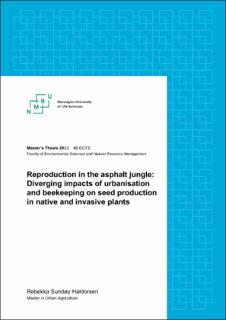| dc.description.abstract | * Urbanisation is increasing worldwide, posing a potential threat to pollinator communities and subsequently the delivery of pollination services to wild plants. However, studies are diverging on whether urbanisation positively, neutrally, or negatively correlates with wild pollinators – often due to variations in the surrounding landscape or different definitions of ‘urban’. Furthermore, the apiculture of honey bees (Apis mellifera) shows tendencies of a negative influence on wild pollinators and increased spread of invasive plant species. Therefore, it is interesting to investigate whether urbanisation and apiculture influence the dichotomy of conserving native plants while extirpating invasive plants.
* I have conducted a study on pollen limitation in the two plant species Bunias orientalis (invasive) and Lotus corniculatus (native) along a landscape diversity and urbanisation gradient in 35 sites in Porsgrunn and Skien municipalities, Norway. I measured pollen limitation by comparing seed numbers and weight for hand pollinated flowers versus controls (naturally pollinated flowers) along the landscape gradients. Further, visits of insect pollinators were recorded to investigate how the pollinator community correlated with the landscape gradients, how their presence correlated with pollen limitation in B. orientalis and L. corniculatus, and how honey bees correlated with wild insects.
* I found that seed numbers in the invasive B. orientalis increased with landscape diversity, indicating lower pollen limitation and a good ability to spread in heterogeneous landscapes. Seed numbers in the native L. corniculatus correlated negatively with urbanisation, indicating high pollen limitation and a lower ability to spread in urban areas. Considering insect visits, I want to highlight the finding of a positive correlation between seed numbers and honey bee visits in B. orientalis. As a consequence, honey bees might reduce pollen limitation in the invasive B. orientalis, potentially leading to increased spread.
* Synthesis: The invasive B. orientalis and native L. corniculatus are interesting from a management perspective since they represent the contradictive management goals of extirpating invasive plants and conserving native plants. This study shows that knowing how landscape variables affect pollen limitation in a plant is important before applying management initiatives to reassure that the desired effect applies. The indication of increased seed set in the invasive B. orientalis from honey bee visits highlights the need for precaution when placing beehives in urban areas. | |
